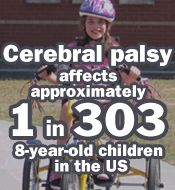Cerebral Palsy Occurrence in the US
Cerebral palsy is the most common motor disability in childhood, affecting approximately 1 in 303 8-year-old children in the US.

Cerebral palsy (CP) is a group of disorders that affect a person's ability to move and maintain balance and posture. CP is one of the developmental disabilities that is tracked by the Autism and Developmental Disabilities Monitoring (ADDM) Network, a multi-site surveillance program funded by the Centers for Disease Control and Prevention (CDC).
Researchers from the ADDM Network recently released a report on the prevalence (occurrence) and features of CP in 8-year-old children living in four areas of the United States in 2006. This report is the first multi-site, population-based study in the US to provide estimates of co-occurring developmental disabilities, gross motor function, and walking ability among children with CP. This report also presents updated CP prevalence data.
For 2006, the ADDM CP Network reported that:
- The average prevalence of CP was approximately 3.3 per 1,000 or 1 in every 303 8-year-old children living in areas of Alabama, Georgia, Missouri, and Wisconsin;
- CP prevalence varied by site, ranging from 2.9 per 1,000 8-year-olds in Wisconsin to 3.8 per 1,000 8-year-olds in Georgia;
- Overall, CP prevalence was significantly lower among Hispanic children than among Black or White children;
- CP, on average, occurred 1.2 times more frequently among boys than among girls;
- Spastic CP was the most common type of CP, found among approximately 80% of children with CP; and
- While 56% of children with CP were able to walk independently, 33% had limited or no walking ability.
Children with CP and their families have a pressing need for enhanced health, education, and intervention services. Population-based data on CP prevalence, level of function, and co-occurring developmental disabilities can increase our understanding of the complexities of CP and inform planning for services and community participation.

More Information
- CDC's "Learn the Signs. Act Early." Campaign (also available in Spanish)
- Cerebral Palsy
- Reaching For The Stars: A Foundation of Hope For Children With Cerebral Palsy
- American Academy of Cerebral Palsy and Developmental Medicine
- Cerebral Palsy International Research Foundation
Reference
Kirby RS, Wingate MS, Van Naarden Braun K, Doernberg NS, Arneson CL, Benedict RE, Mulvihill B, Durkin MS, Fitzgerald RT, Maenner MJ, Patz JA, Yeargin-Allsopp M. "Prevalence and functioning of children with cerebral palsy in four areas of the United States in 2006: a report from the Autism and Developmental Disabilities Monitoring Network." Res Dev Disabil. 2011 Mar-Apr;32(2):462-9. Epub 2011 Jan 26.
CDC works 24/7 saving lives and protecting people from health threats to have a more secure nation. A US federal agency, CDC helps make the healthy choice the easy choice by putting science and prevention into action. CDC works to help people live longer, healthier and more productive lives.
Get email updates
To receive email updates about this page, enter your email address:
Contact Us:
- Centers for Disease Control and Prevention
1600 Clifton Rd
Atlanta, GA 30333 - 800-CDC-INFO
(800-232-4636)
TTY: (888) 232-6348 - cdcinfo@cdc.gov



